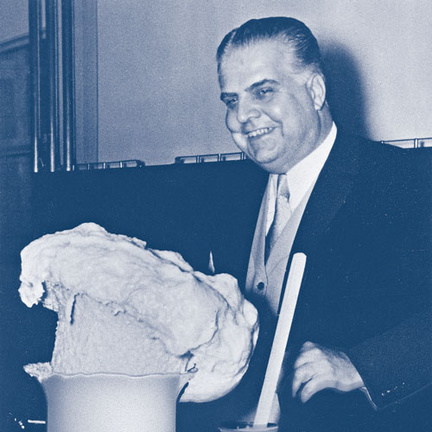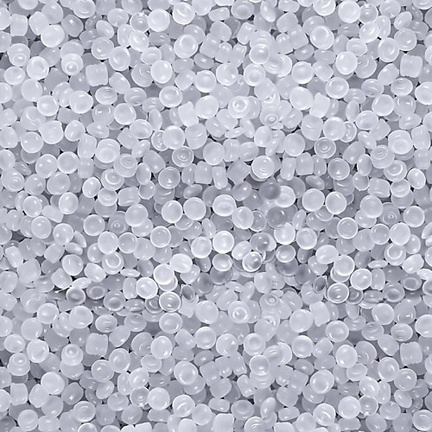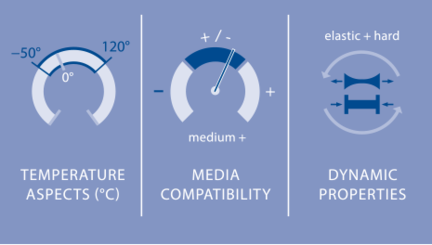Thanks to their high elasticity and their very good resistance to wear and abrasion, elastomers made of rubber are generally superbly suited to seals. But they also have disadvantages: Due to their limited Shore hardness (a maximum of 90 SH A), they are not suited to applications at all levels of pressure. Dynamic applications are only achievable with the use of lubricants. Freudenberg Sealing Technologies polyurethane materials offer an alternative in cases where rubber elastomers cannot be used or where highly specialized elastomers are out of the question for cost-related reasons.
History
 Dr. Otto Bayer" width="200" height="227" />
Dr. Otto Bayer" width="200" height="227" />
In 1937, a research group at I.G. Farben led by Dr. Otto Bayer (1902–1982) produced polyurethane (PU) synthetically for the first time, and the material made its triumphant march around the world. The industrial production of PU began in 1940. The first foam material based on PU was developed between 1952 and 1954. Many additional developments based on PU followed over the course of decades. As early as 1960, the production of PU foam material came to 45,000 tons. Global demand has greatly increased since then. At present, more than 12 million tons are processed annually. Today it is difficult to imagine our everyday lives without polyurethanes. They are actually one of the most multifaceted categories of plastic. We encounter them as soft polyester foams, as thermal insulating materials, in the soles of our shoes and in the steering wheels of our cars. Polyurethanes above all owe their wide distribution to two special attributes: They can be produced by mixing liquid feed materials. This can even be done in small processing operations. And since innumerable feed materials are available, it is possible to manufacture made-to-order materials in consistencies ranging from soft to hard or from foamed to compact, for a broad range of applications.
Production
Polyurethanes (PU) are plastics that result from the polyaddition reaction of multifunctional polyisocyanates with multivalent alcohols, or polyols. Depending on the product desired, the chemical formulas can contain components such as catalysts, expanding agents, and possibly flame retardants or substances to protect against hydrolysis and oxidation. The number of the additional components is generally limited to six. Various combinations make possible the production of a number of product types such as hard and flexible foam materials, hard and flexible structural foams, adhesives, coatings and finishes, along with sealants. The quantity of the expanding agents determines the density and hardness of the product.
Flexibility or strength depends on the type of the polyols or diisocyanates involved. In addition, various forms of polyurethanes are also frequently combined with other materials to produce a multitude of end products. In the production of polyurethanes, the plastics not only need to be brought into a mold, as is the case with  other polymers. First of all, the mostly liquid feed material must be polymerized. As a result, dosing machines and molding units are the key elements of any processing system. In the dosing machine, the fluid components are first brought to the desired processing temperature in separate containers. At the same time, they are constantly homogenized by a stirring unit. The mixing of the individual components takes place in the desired proportions in the mixing head. This can occur with the use of a stirring unit in a low-pressure process or at pressures up to 200 bar in a high-pressure process. Then the still fluid reaction mixture leaves the mixing chamber even before the polymer formation is complete.
other polymers. First of all, the mostly liquid feed material must be polymerized. As a result, dosing machines and molding units are the key elements of any processing system. In the dosing machine, the fluid components are first brought to the desired processing temperature in separate containers. At the same time, they are constantly homogenized by a stirring unit. The mixing of the individual components takes place in the desired proportions in the mixing head. This can occur with the use of a stirring unit in a low-pressure process or at pressures up to 200 bar in a high-pressure process. Then the still fluid reaction mixture leaves the mixing chamber even before the polymer formation is complete.
The discharge occurs discontinuously in the form of “shots” to fill the subsequent closed or open molds. The molds in the molding unit are mostly made from metal – and from synthetic resin for short production runs. They take up the reaction mixture, ensure that the reaction temperature is maintained, absorb pressure and draw off the resulting gases without the actual material escaping. If desired, reinforcing elements can also be inserted in the molds. Next to this process – known as the casting method – the extrusion process is the most important manufacturing option. Bands or strands of polyurethanes are manufactured with the help of a dosing machine or – as mentioned – with an extruder. It is granulated after hardening. This granulate can be further processed with an extruder like a normal thermoplast.
Physical Properties
Depending on their manufacture, polyurethanes can be hard and brittle or soft and elastic. The PU standard material 94 AU 925 from Freudenberg Sealing Technologies has a density of 1.18 g/cm³ at 23°C in accordance with DIN EN ISO 1183 and thus lies in the rubber range (1.1–1.4 g/cm³) – but, at 94 Shore A, is 4 points harder. At 64 N/mm², its tensile strength (DIN ISO 53504, S2, 23°C) is more than double that of rubber. Based on the same norm, in the elongation-to-rupture test, the PU standard material achieves a value of 500 percent compared to a maximum of 400 percent for rubber, whose compression set (DIN ISO 815, B, 24 h, 100°C, 20 percent) reaches a maximum of 30 percent. The PU standard material 94 AU 925 exceeds it by 5 percentage points.
But its most outstanding characteristic is its tear strength (DIN ISO 34-1), which exceeds that of rubber by a factor of 4-6. This value stands at 180 N/mm for Freudenberg Sealing Technologies materials.
With the new material 94 AU 30000, Freudenberg Sealing Technologies is keeping abreast of changing market requirements. The seals of the new polyurethane generation are especially suited to construction and agricultural machinery as well as materials-handling technology. Operators in these sectors are increasingly turning to leased machinery. That means longer operating times than would be the case for exclusive operation by owners. The performance limits are also more frequently exceeded. That is why high-performance materials are needed to make extended periods of operation possible. In addition, the market is increasingly demanding global solutions. Common parts are mandatory since they can be used universally and thus help to reduce costs. The new polyurethane generation fulfills the requirements for a material that can be utilized universally. Previously, manufacturers often had to keep reserves of different versions of components such as hydraulic cylinders – depending on the region of the world where they were used and on the medium that the hydraulic system required for its operation. Today every construction-machinery manufacturer is building equipment for worldwide use, from the Arctic to the desert. The universal range of applications of the new polyurethane generation is taking this precise trend into account.
 PUR, PU
PUR, PU
New Polyurethane
Once again in 2013, Freudenberg Sealing Technologies greatly increased the versatility of polyurethanes with a completely new generation of products. The material 94 AU 30000 sets new standards and is excellent testimony to one of our core competencies: the development of our own materials: 94 AU 30000 is superior to other polyurethanes in all areas. It offers a significantly longer service life and even withstands wide temperature fluctuations. Its range of application is between –50°C and 120°C. This became possible through the targeted modification of the PU components responsible for thermal characteristics and the especially favorable viscoelastic behavior of the new material. In practice, this means that seals made of 94 AU 30000 are flexible at low temperatures and sufficiently stable at high temperatures. The new PU generation is also more resistant to hydrolysis².

